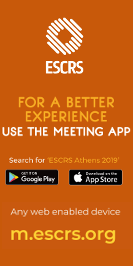Posters
(results will display both Free Papers & Poster)
A novel method for treatment of recurrent pterygium using the simple limbal epithelial transplantation technique: a case series
Poster Details
First Author: T.Trinh CANADA
Co Author(s): Z. Mednick T. Boutin A. Einan N. Sorkin G. Santaella A. Slomovic
Abstract Details
Purpose:
Pterygium recurrence is not an uncommon complication of pterygium removal. Multiple surgical and medical approaches attempting to reduce recurrence rates have been described in the literature. The present case series proposes a novel method to treat recurrent pterygia by using the simple limbal epithelial transplantation (SLET) technique.
Setting:
Single tertiary corneal referral centre in Toronto, Canada.
Methods:
A single surgeon performed all four cases of simple limbal epithelial transplant in cases of recurrent pterygium using the same technique. Mean age was 60 years (range 37-79 years). Three of the 4 eyes had only one prior pterygium removal with conjunctival autograft and one case had 3 prior removals. All cases used ipsilateral limbal tissue identified clinically as healthy by the presence of a normal limbal-conjunctival junction. Patients were followed up with a minimum follow up time of 10 months (mean 12.75 months). Patients were assessed for recurrence, BCVA, presence of residual amnion and/or SLET pieces, and neovascularisation.
Results:
The cases of four patients who presented with recurrent pterygium were reviewed. The SLET procedure went without complication in all cases. No significant recurrences were detected at ten months. All cases experienced an improvement in visual acuity and improvement in ocular surface discomfort.
Conclusions:
This is the first case series of SLET being used as a treatment modality for recurrent pterygium. SLET recovery is longer than pterygium excision and autoconjunctival technique, involving slow absorption of the amnion and SLET tissue. Further studies are required to more reliably demonstrate the utility of the procedure in this clinical circumstance, but our results are encouraging that in select patients, this may be a viable option in treating aggressive recurrent pterygia.
Financial Disclosure:
None



